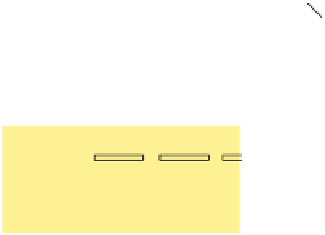Geoscience Reference
In-Depth Information
Table 16.1(3). Countermeasures against liquefaction (modified fromJGS, 1998)
Principle of
improvement
Description
Lift prevention pile or sheet pile
Constraint of surroundings
Buried pipe
Liq
Liq
Weight
Sheet pile
Underground
structure
Non-liq
Non-liq
Absorption of ground deformation by flexible joint
Provision of supplemental foundation for mat foundation
Upper structure
Structural
counter-
measure
Liq
Liq
Frexible joint
Upper structure
Top-sharped concrete block
Non-liq
Non-liq
Reinforcement of mat foundation by geogrid
Sheet piling for embankment
Upper structure
Tie rod
Liq
Liq
Geogrid
Sheet pile
Non-liq
Non-liq
Liq : Liquefiable layer
Non-liq : Non liquefiable layer
(3) In tank yards or housing complexes, small machines must be used because many
structures standclose each other.
(4) Soil investigation in the ground under existing structures is difficult. Geotechnical
data is needed toestimate liquefaction potential and appropriate countermeasures.
Of the two categories of remediation methods shown in Table16.1, generally speaking
techniques to prevent liquefaction are difficult to apply to existing structures. However,
special techniques which can be applied to existing structures, such as the compaction
grouting method and seepage grouting method, have been developed recently.
On the contrary, the remediation techniques in the second category, which strengthen
structures to prevent their collapse if the ground should be liquefied, can be applied
to existing structures easily. Several new techniques have been developed and applied
recently.Inthedesigntostrengthenstructures,theallowabledeformationofthestructures
must be defined because the strengthening effect must be judged based on the deforma-
tion of the structures. This means that performance-based design must be introduced.
However,notenoughstudiesonperformance-baseddesignhavebeenundertaken.Onlya
few allowable deformations have been proposed (e.g.,Yasuda, 2005b). Futurestudies on































































































